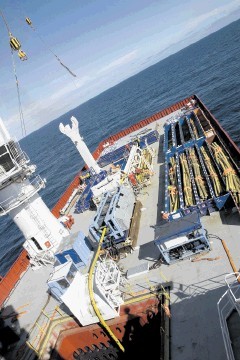
THESE are busy times at Fugro Subsea Services in Aberdeen.
The company’s latest construction support vessel, Fugro Symphony, is settling into her stride; a unique trenching system geared to oil and gas and marine renewable work under development; and the successful first commercial deployment of a module that enables a work-class ROV to convert to a crawler for seafloor work in tough conditions, with a second system also being built.
It adds up to significant ongoing investment in the company’s future as a key player in offshore energy support, according to Fugro Subsea Services managing director, Grant Aitchison.
Highlighting the successful debut of the Fugro Symphony that was delivered in May, and which features dual 3,000m capability own-brand ROV systems, Mr Aitchison said: “She’s settling in. We’ve done a lot of work with Chevron in the North Sea, carrying out inspection and engineering intervention on the Captain field’s FPSO.
“This is the first time that some of the FPSO intervention work has been done using ROVs. We also used simulation technology developed and built in-house to engineer and rehearse the various tasks, so that when we deployed offshore the ROV pilots and offshore crew were already familiar with many of the challenges that they would encounter, and therefore equipped to handle in an efficient manner, so saving the client time and money.”
Fugro Symphony has experienced very few shakedown issues and the ROV systems have bedded in well, though they have yet to work to their full 3,000m potential.
“We see opportunities to export that to deepwater areas like West Africa, which is a key focus for us in the future,” said Mr Aitchison. “Meanwhile, Fugro Symphony’s sister, Fugro Saltire, is currently working offshore Egypt for Technip and will remain there to the end of the year.”
A hallmark of Fugro Subsea Services is its bold approach in developing new technologies, and that includes bringing innovation to the trenching market which, though well established, is narrow and needs fresh thinking, especially for maritime renewable and deepwater oil and gas.
This is why the company recently decided to break into the trenching market by applying a fresh approach.
“We’ve placed a contract with SMD to build a high specification trenching system that we will take delivery of in May next year,” said Mr Aitchison. “Through the acquisition of TS Marine, we now have a lot of experience in that area and see a lot of trenching opportunities coming up over the next few years.
“At the moment, competition in the jet-trenching market is limited and our unique system will be both oil and gas and marine renewables capable. There is a lot of interest from the renewables side and this will build on services already provided by Fugro.”
“Given Fugro’s considerable knowledge of seabed conditions coupled with our survey and ROV expertise, this should be able to give us a competitive advantage when bidding for trenching jobs.”
Introduced to Energy readers earlier this year, the ROV crawler unit, designed to enable work-class ROV’s to work on the seafloor in difficult tidal conditions, has made a successful debut, supporting commissioning of a large-scale windfarm in the Southern North Sea. Basically, it means that an ROV can work an entire tidal cycle without the need for recovery when currents, tidal conditions and poor visibility would normally limit working time.
“We have proven that the crawler is capable of keeping an ROV on the sea floor in a stable position through the high currents, poor visibility and difficult conditions that the SNS is famous for,” said Mr Aitchison.
“Indeed it has enabled us to conduct a survey of an export power cable linking the windfarm with the beach successfully. I believe this is a milestone in terms of being able to accurately verify cable position and depth of burial for a windfarm’s operator.”
The first generation system is now back in Aberdeen for upgrade and improvements following feedback from its successful first campaign, and Fugro Subsea Services has plans to build additional systems.
“This has generated significant interest and we are discussing further windfarm depth of burial survey work for the immediate future. This includes not only surveying export cables but also inter-array cabling between turbines,” added Mr Aitchison.
There is a substantial market and Fugro is in pole position to capitalise on it as the first company to effectively solve the challenge of maximising ROV in-water time in challenging tidal conditions.
“Having our in-house ROV and subsea engineering departments working closely together in developing the crawler skid, has enabled us to transform the capabilities of our workclass ROVs.
“We’ve delivered a service to the market that previously did not exist and we’ve been able to package that together with cable tracking technology developed by Innovatum to deliver a dataset that was previously impossible to do.”